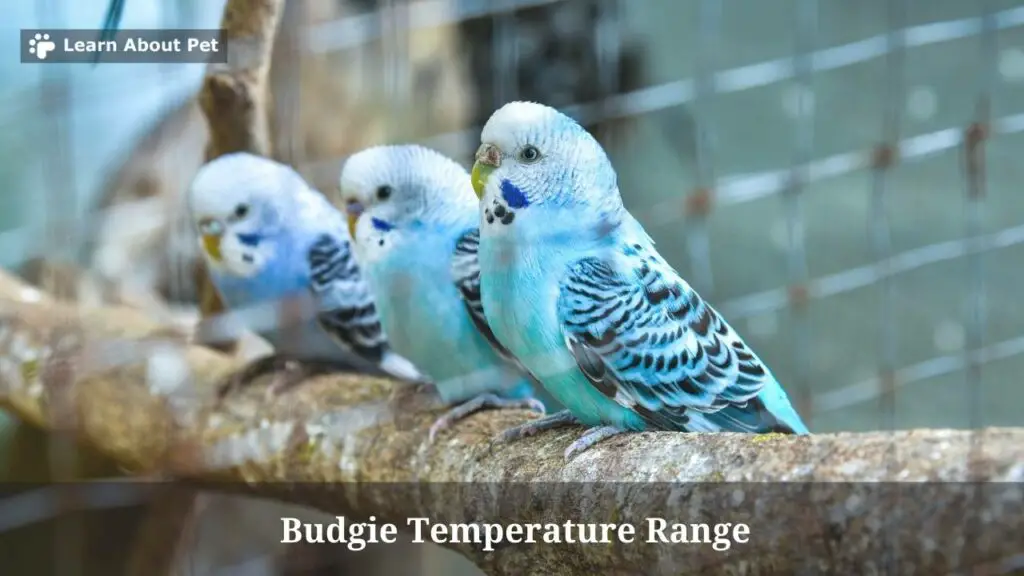One challenge that people who keep budgies as pets face is that of ensuring that the budgies don’t get too hot or too cold. To be able to do this, one needs to know what the ideal temperature range for a budgie is. Read on, to find out.
The ideal budgie temperature range is between 70 degrees and 75 degrees Fahrenheit. By all means, you shouldn’t allow a budgie to be in temperatures below 40 degrees or above 90 degrees Fahrenheit.
What can be even more dangerous to a budgie is an abrupt change in temperature. Thus a sudden dip from 70 degrees to 40 degrees Fahrenheit can really harm a budgie.
It is important to appreciate that budgies originated from warm Australian deserts. They therefore lack adaptations to cope with extreme cold weather conditions.

Sometimes, you may even hear of cases in which a budgie died of cold.
Thus understanding the tolerable budgies temperature range can help you save your bird’s life.
If winter is approaching for instance, you need to make some preparations for budgies and house temperature this winter.
You specifically need to know what temp is too cold for budgies. Then ensure that your budgie is never exposed to temperatures below that.
In other words, you need to know how cold is too cold for budgies. Then ensure that the budgies never have to stay below such temperatures.
As the summer approaches, you conversely need to know what temperature is too hot for budgies. Then ensure that under no circumstances do your budgies have to live above such temperatures.
What Is The Ideal Budgie Temperature Range?
One question that keeps on coming up in forums in which budgie owners share perspectives is on what temperature range is ideal for the budgies.
So, indeed, what temperature range is the best for budgies? In other words, what temperature should budgies live in, ideally? What is a good temperature for budgies?
That turns out to be between 70 degrees and 75 degrees Fahrenheit.
Thus if you were wondering, what is the optimal room temperature for budgies, that is the answer.
When you convert the ideal budgie temperature range Celsius units, that turns out to be between 21 degrees and 24 degrees Celsius.
So if it is possible, you need to keep your budgies in that temperature range.
Outdoor and indoor temperature for parakeets (budgies) should ideally be in this range.
There is some flexibility though. Whereas 70 to 75 degrees Fahrenheit is most ideal for budgies, they can nonetheless be reasonably comfortable at as low as 65 degrees and as high as 80 degrees Fahrenheit…
While at it, one may ask, can parakeets withstand heat and cold outdoors? And the answer is yes: though there are limits below or beyond which their safety may be at risk.
So it is essential to maintain comfortable temperatures for budgies with changing seasons. This means aiming for the ideal budgie temperature range: 70 to 75 degrees Fahrenheit.
What Temperatures Can Budgies Tolerate?
So far, we have been dealing with the ideal budgies temperature range.
But as we all know ‘ideals’ are not always attainable. Therefore people at times endeavor to know which are the maximum and minimum temperatures that budgies can tolerate.
This is in a bid to figure out what temperature is safe for budgies. Therefore the focus is on what temperature can budgies withstand?
So, indeed, what temperature is too hot for budgies? This turns out to be anything above 90 degrees Fahrenheit.
And what temperature is too cold for budgies? That turns out to be anything below 40 degrees Fahrenheit.
So budgies may be able to tolerate temperatures in the 40 degree to 90 degree Fahrenheit range. However, that is not the ideal temperature range for budgies.
The ideal range is between 70 and 75 degrees Fahrenheit.
You should try to ensure that the temperature under which your budgies are doesn’t drop below 60 degrees Fahrenheit.
That is especially important at night. Do budgies get cold at night? The answer is yes. But don’t allow the temperature under which your budgies are to fall below 60 degrees.
On the other hand, try to ensure that the temperature under which your budgies are doesn’t rise above 80 degrees.
But whatever happens, know that if the temperature falls below 40 degrees or rises above 90 degrees Fahrenheit, your budgie’s safety will actually be at risk.
What Temperature Is Too High For A Budgie?
Any temperature that is above 90 degrees Fahrenheit is too high for a budgie.
At that sort of temperature, the budgie is at risk of suffering from heatstroke, among other issues.
90 degrees Fahrenheit translates into about 32 degrees Celsius. Thus if you were wondering, can I keep my budgies outside at 45° Celsius, now you know that the answer is obviously ‘no’.
If 32 degrees Celsius is already considered too high for a budgie, you can imagine what we would say about 45 degrees Celsius.
All said and done, any temperature above 90 degrees Fahrenheit (32 degrees Celsius) is too high for a budgie.

What Temperature Is Too Cold For Budgies?
Any temperature below 40 degrees Fahrenheit is too low for a budgie.
At that sort of temperature, your budgie is actually at risk of dying from cold.
40 degrees Fahrenheit translates into about 4 degrees Celsius.
In fact, you should start thinking of how to keep budgies warm once the temperature drops below 60 degrees Fahrenheit.
You need to remember that budgies are birds whose original habitat is warm. They therefore have very few adaptations to cope with extreme cold.
Temperatures that are too low seem to affect them more badly than temperatures that are too warm.
You should therefore know that your budgie is likely to start getting uncomfortable when temperature drops below 60 degrees.
And if the temperature falls further below 40 degrees Fahrenheit, the budgie’s safety will be at risk.
How Do I Know If My Budgie Is Cold?
It is quite easy to tell if your budgie is too cold. Usually, a budgie that is too cold will tend to shiver.
Another sign that a budgie is too cold is that of puffing feathers. This is something that the budgie does in a bid to ensure that the remaining heat that is in its body doesn’t dissipate.
So you may see feather puffing or shivering behavior. Then you check, and find that the temperature is indeed somewhere below the ideal range for a budgie. In that case, you would need to know that those are signs of coldness.
Should such a bird’s temperature not be raised, it may end up dying.
How Do I Know If My Budgie Is Too Hot?
It is not too hard to tell if your budgie is too hot either.
Usually, a budgie that is too hot will open/spread its wings out. This is in a bid to let out the excess bodily heat that is making it uncomfortable.
Further, a budgie that is too hot will tend to also open its beak, and keep it open. Again, this is in a bid to let out the excess bodily heat that is making it uncomfortable.
If the budgie is outside, it may show shade-seeking behaviors.
All these are signs to tell you that your budgie is too hot.
The beak opening and wings spreading behaviors are especially reliable, as signs that a budgie is too hot.
How Do You Protect A Budgie From Getting Too Cold?
There are several ways in which you can go about keeping a budgie warm.
One way is by using a heat-producing bulb. This should be one that produces just enough heat: not too much. Otherwise you will end up with another problem in your hands (of an overly hot budgie).
Another way to keep a budgie warm is by simply closing the windows. This way, cold winds won’t find their way in.
Yet another way to keep a budgie warm is by covering the budgie’s cage.
If you have a central heating system, you can fire it up. This way, both you and the budgie will get to enjoy a more comfortable temperature.
How Do You Protect A Budgie From Getting Too Hot?
There are several ways to protect a budgie from getting too hot.
One simple tool that can help you in this regard is a birdbath. So you would be having the budgie dip into the birdbath whenever it feels too hot.
Fans and air conditioning can also be helpful: though you need to ensure that they don’t blow directly onto the budgie’s body.
If they blow directly onto the budgie’s body, this can have an undesirable effect. That is the effect of drying and cracking of some parts of the budgie’s body.
Final Verdict – Budgie Temperature Range
The ideal temperatures for budgies are between 70 and 75 degrees Fahrenheit.
70 to 75 degrees Fahrenheit translates into about 21 to 24 degrees Celsius.
Budgies originate from warm Australian deserts, hence their preference for such warm temperatures. The budgies are actually not very well equipped to cope with extremely low temperatures.
The lowest temperature that a budgie will tolerate is about 40 degrees Fahrenheit. And the highest temperature that a budgie will usually tolerate is about 90 degrees Fahrenheit.

Below 40 degrees Fahrenheit and above 90 degrees Fahrenheit, the budgie’s safety may be endangered.
You can tell that a budgie is too cold if you see feather puffing, shivering and other related behaviors.
And you can tell that a budgie is too hot if you see beak opening, wing spreading and other related behaviors.
You should endeavor to ensure that your budgies stay in (or close to) temperatures within the 70 to 75 degrees Fahrenheit range.
As a pet lover, make sure to learn about pet more and give your pet parakeet a good and comfortable life!

Welcome to Learn About Pet. My name is Rajkumar Ravichandran and I love all pets, travel, and amazing food. I write about my passion and personal experience caring for multiple pets in this blog! ❤️
Post Disclaimer
DISCLAIMER: THIS BLOG OR WEBSITE, "Learn About Pet", DOES NOT PROVIDE YOU WITH MEDICAL ADVICE AND IS NOT A SUBSTITUTE FOR MEDICAL ADVICE. ALWAYS GET IN TOUCH WITH YOUR PERSONAL VETERINARIAN AND USE INFORMATION HERE AS GENERAL ADVICE.
The information, including but not limited to, text, graphics, images and other material contained on this website are for informational purposes only. No material on this site is intended to be a substitute for professional veterinary advice, food recommendation, diagnosis, or treatment. Always seek the advice of your veterinarian or other qualified health care provider with any questions you may have regarding a medical condition or for pet food related questions.








Данный ресурс создан для поиска занятости в разных регионах.
Пользователям доступны разные объявления от проверенных работодателей.
Система показывает объявления о работе по разным направлениям.
Полный рабочий день — всё зависит от вас.
https://my-articles-online.com/
Навигация простой и подстроен на новичков и специалистов.
Оставить отклик очень простое.
Хотите сменить сферу? — начните прямо сейчас.